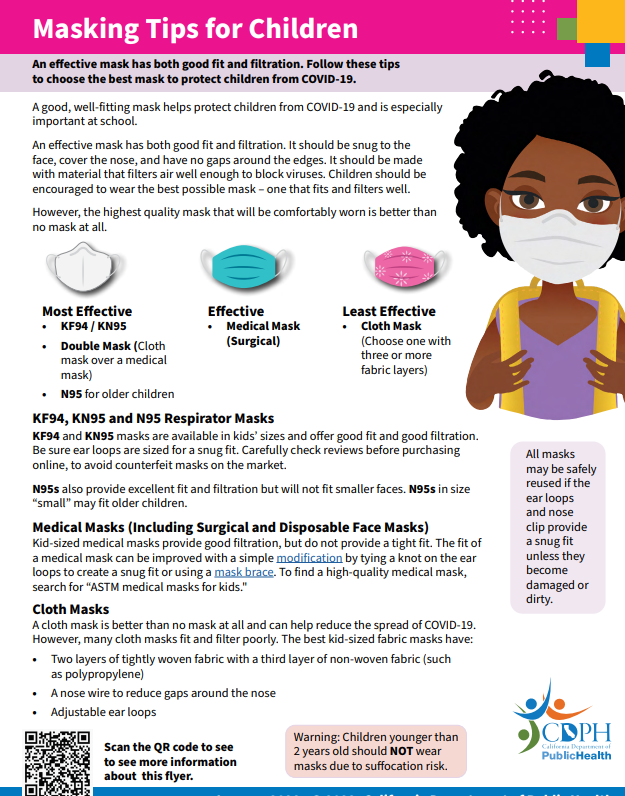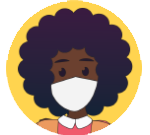COVID-19


In most circumstances, masking may be recommended for individuals in the community based on the level of COVID-19 in the community, as reported by weekly CDC COVID-19 Hospital Admission Levels. In addition, everyone should consider their own individual risk level when choosing whether to mask. Everyone is recommended to mask:
- If you are exposed to someone with COVID-19, for 10 days from the last day that you were exposed. This is especially important when around those at higher risk for severe COVID-19 disease. Follow all the instructions at publichealth.lacounty.gov/covidcommunity.
- In healthcare settings, when visiting or receiving care. (Note: this is required when LA County COVID-19 Hospital Admission Level is Medium or High).
- On public transit and in transportation hubs, especially during times of increased transmission including the annual winter respiratory virus season. See CDC's Masking During Travel guidance.
- If you or someone you spend time with are at risk for severe illness. You should wear your most protective mask, such as a N95, KN95, or KF94 respirator, when you are indoors in public. This is especially important when you are in crowded or poorly ventilated places.
REQUIREMENTS
When the level is LOW , MEDIUM , or HIGH , you MUST wear a mask:
- As required in the workplace by Cal/OSHA and LACDPH Health Officer Order (see below).
- If it is required by the site, including some businesses, health facilities, schools, and workplaces.
- If it is required by Public Health for managing an outbreak, including in workplaces and congregate settings.
- If you have COVID-19 and must be around others until you end isolation. This includes when you are at home. If you are eligible to end isolation, you must continue to wear a mask around others from Day 6 through Day 10. The exception is that if you have two negative COVID-19 tests in a row that were taken at least a day apart, you do not need to wear a mask. Follow all the isolation instructions at ph.lacounty.gov/covidisolation.
Note that if you are returning to the workplace after a COVID-19 infection you are required to mask around others through Day 10 per Cal/OSHA.
RECOMMENDATIONS
THE LEVEL IS CURRENTLY LOW , so it is STRONGLY RECOMMENDED that you wear a mask indoors: (unless required – see above)
- If you are a close contact to someone with COVID-19 for 10 days from the last day that you were exposed. This is especially important when around those at higher risk for severe COVID-19 disease. Follow all the instructions for close contacts at ph.lacounty.gov/covidcontacts.
- If you have any respiratory symptoms (such as a cough, runny nose, sore throat) and you need to be around others.
- In healthcare settings, when visiting or receiving care.
- On public transit and in transportation hubs (See CDC’s Masking During Travel guidance.)
In all other settings, you are encouraged to choose to wear a mask based on your preference and personal risk.
**No one can be prevented from wearing a mask to participate in an activity or enter a business.**
If the local COVID-19 impact level increases, then mask wearing becomes increasingly important.
- If you are at risk for severe illness, wear your most protective mask, such as a N95, KN95, or KF94 respirator, when you are indoors in public. This is especially important when you are in crowded or poorly ventilated places.
- If you share a home or spend time with someone who is at risk for severe illness, wear a mask when you are indoors with them. Also, consider taking a COVID-19 self-test before you see them.
When the level increases to HIGH
- Follow the above guidelines for when the COVID-19 impact level is MEDIUM .
- Additionally, everyone should wear a mask when indoors in public.
RULES AND RECOMMENDATIONS FOR WORKERS
REQUIREMENTS
Healthcare and Direct Care Settings
All healthcare personnel working in licensed healthcare facilities in LA County who have not received both an annual influenza and an updated COVID-19 vaccine ARE REQUIRED TO wear a respiratory mask for the duration of respiratory virus season (November 1 – April 30) when in contact with patients or when working in patient-care areas. See the Health Officer Order for details.
Other Workplace Settings
Cal/OSHA employers ARE REQUIRED TO follow the Cal/OSHA COVID-19 Prevention – Non-Emergency Regulations or, in some workplaces, the Cal/OSHA Aerosol Transmissible Diseases (ATD) Standard. Cal/OSHA has more protective masking rules for workers in certain situations. Examples include:
- Workers who are returning to work after having COVID-19 infection ARE REQUIRED TO wear a mask around others through Day 10. See Cal/OSHA FAQs: Exclusion Requirements for Employees Who Test Positive.
- If there is an outbreak in a workplace, all exposed employees ARE REQUIRED TO wear a mask when indoors, or when outdoors and less than six feet from another person for 10 days after last exposure. See Cal/OSHA FAQs: Outbreaks.
Review the Cal/OSHA links above for more information on the COVID-19 Prevention regulations.
When workers are not required to wear a mask, employers must allow workers to wear a mask if they want to, unless it would create a safety hazard, such as interfering with the safe operation of equipment. See Cal/OSHA FAQs: Face Coverings.
RECOMMENDATIONS
Healthcare and Direct Care Settings
Workers in healthcare facilities and direct care settings ARE STRONGLY RECOMMENDED TO wear a mask when they are providing care or working in-person with patients, clients, and residents.
commenting out table-->
For a mask to work well, it needs to have both a good fit and good filtration:
- Good fit means that the mask covers your mouth and nose and fits snugly against the sides of your face and your nose.
- Good filtration means the material that the mask is made of blocks airborne particles well. You can get good filtration by wearing a mask that has several layers made of certain specialized materials.
The best mask has a high-quality filter, fits well against your face, and is comfortable enough for you to wear consistently.
For the best protection, wear a well-fitting respirator. If you can’t use a respirator, you can make your mask work better by improving the fit and filtration.

* Some cloth masks are designed with specialized filter/layers and are tested to demonstrate that they perform at a consistent level. The American Society for Testing and Materials (ASTM) has set a standard (ASTM F3502-21) for barrier face coverings, including cloth ("reusable") masks. The most protective ASTM F3502-21 performance level masks have a particulate filtration efficiency of at least 95%. ASTM F3502-21 performance level ratings for some commercially available face masks are published on the CDC/NIOSH website Barrier Face Coverings and Workplace Performance/Performance Plus Masks. If you are considering purchasing a cloth mask, look for ones with high performance level (≥95% particulate filtration efficiency) and that have been tested by an accredited third-party laboratory.
For detailed information on different types of masks visit:
- CDC Types of Masks and Respirators
- CDPH Get the Most Out of Masking
Masks and Respirators
Masks are made to protect others by containing droplets and particles that you breathe, cough, or sneeze out. If they fit closely to the face, they can also provide you some protection from particles spread by others, including the virus that causes COVID-19.
Respirators (such as N95s, KN95s, and KF94s) are specialized masks that are made to protect you by filtering the air and fitting closely on the face to filter out particles, including the virus that causes COVID-19. They can also contain droplets and particles you breathe, cough, or sneeze out so you do not spread them to others.
Respirators provide the best protection against airborne diseases, including COVID-19. Learn more.
How to improve the fit and filtration of your mask
- Wear a double mask-this is wearing a well-fitting cloth mask over a medical mask. It makes the medical mask fit better and improves filtration by adding extra layer(s).
- Use a mask fitter or brace—these devices are worn over a medical or cloth mask to reduce the leakage around the edges.
- Knot the ear loops close to the edge of the mask and tuck the excess material so there is no gap. See Knot and Tuck video.
- Choose a mask with straps that go round your head for a tighter fit.
- Wear a mask with nose wires.
- Certain types of facial hair, like beards, can make mask fitting difficult. People with beards can trim them, use a mask fitter/brace, or double mask.
- Double masking does not work with two medical masks because they are too loose.
- Respirators should not be worn with a second mask or a brace/fitter as this interferes with the fit.
Tips to check that your mask fits:
- Check for gaps by cupping your hands around the outside edges of the mask and feel for any air leakages. Make sure no air is flowing from the area near your eyes or from the sides of the mask.
- If the mask has a good fit, you will feel warm air come through the front of the mask and may be able to see the mask material move in and out with each breath.
- If you have to continually adjust your mask, it might not fit properly. Consider trying different types or sizes of masks.
Who should not wear a mask
The following people should not wear a mask:
- Children under age 2.
- People who cannot safely wear a mask, such as someone who is unconscious, incapacitated, or who is unable to remove a mask without help.
- Workers in situations where wearing a mask would create a risk, as determined by local, state, or federal regulators or workplace safety guidelines.
For more information on masks and people with disabilities, including those who are deaf or hard of hearing, see CDC Masks: Special Considerations Section.
More information
CDC and CA State mask guidance websites
- CDC Masks
- CDPH Get the Most Out of Masking
- CDC/NIOSH Respiratory Protection Information Trusted Source (information on respirators)
- CDPH Masking and COVID-19 Fact Sheets and Social Media
- CDC/NIOSH Barrier Face Coverings and Workplace Performance/Performance Plus Masks
- CDC Video Instruction to Improve Medical Mask Fit (Knot and Tuck Technique)
- CDC/NIOSH-How to Put on and Take off a Respirator (PDF)
- CDC/NIOSH-User Seal Check (PDF)
- CDC/NIOSH-Fit Testing (PDF)
- CDC Study - Maximizing Fit for Cloth and Medical Procedure Masks to Improve Performance and Reduce SARS-CoV-2 Transmission and Exposure
- CDC Science Brief: Community Use of Masks to Control the Spread of SARS-CoV-2



